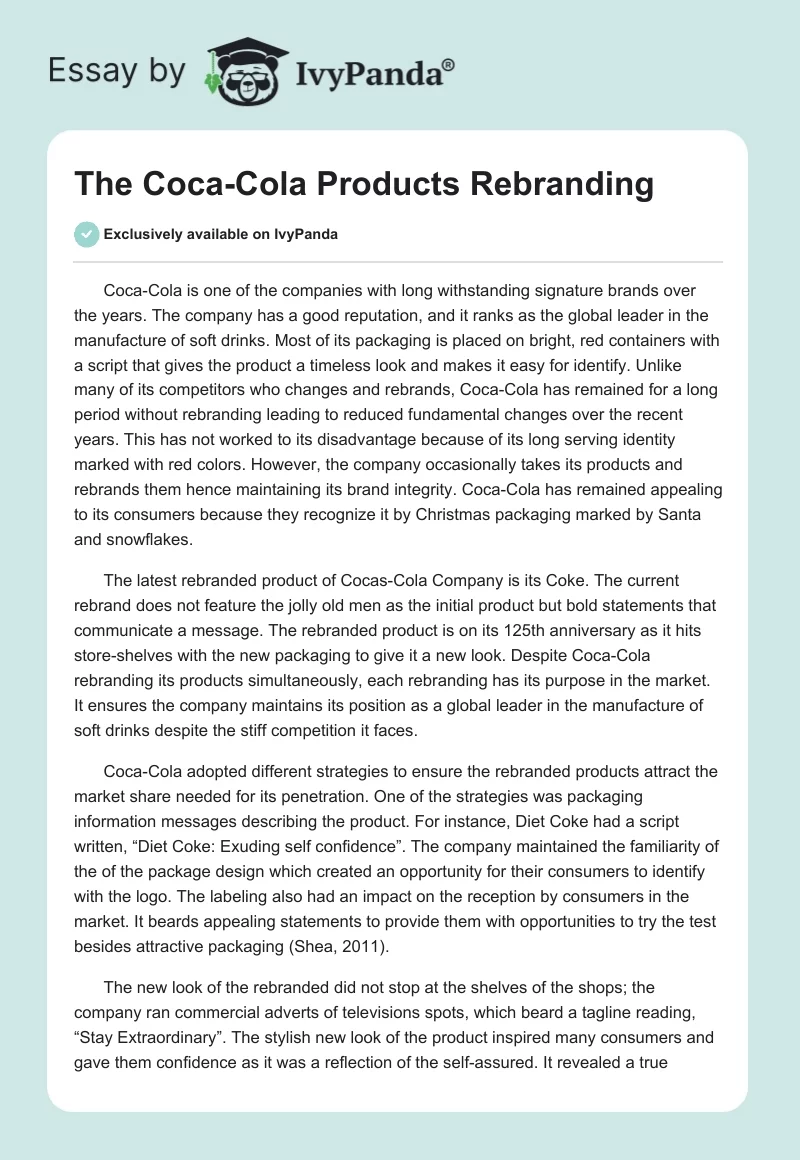Coca-Cola is one of the companies with long withstanding signature brands over the years. The company has a good reputation, and it ranks as the global leader in the manufacture of soft drinks. Most of its packaging is placed on bright, red containers with a script that gives the product a timeless look and makes it easy for identify. Unlike many of its competitors who changes and rebrands, Coca-Cola has remained for a long period without rebranding leading to reduced fundamental changes over the recent years. This has not worked to its disadvantage because of its long serving identity marked with red colors. However, the company occasionally takes its products and rebrands them hence maintaining its brand integrity. Coca-Cola has remained appealing to its consumers because they recognize it by Christmas packaging marked by Santa and snowflakes.
The latest rebranded product of Cocas-Cola Company is its Coke. The current rebrand does not feature the jolly old men as the initial product but bold statements that communicate a message. The rebranded product is on its 125th anniversary as it hits store-shelves with the new packaging to give it a new look. Despite Coca-Cola rebranding its products simultaneously, each rebranding has its purpose in the market. It ensures the company maintains its position as a global leader in the manufacture of soft drinks despite the stiff competition it faces.
Coca-Cola adopted different strategies to ensure the rebranded products attract the market share needed for its penetration. One of the strategies was packaging information messages describing the product. For instance, Diet Coke had a script written, “Diet Coke: Exuding self confidence”. The company maintained the familiarity of the of the package design which created an opportunity for their consumers to identify with the logo. The labeling also had an impact on the reception by consumers in the market. It beards appealing statements to provide them with opportunities to try the test besides attractive packaging (Shea, 2011).
The new look of the rebranded did not stop at the shelves of the shops; the company ran commercial adverts of televisions spots, which beard a tagline reading, “Stay Extraordinary”. The stylish new look of the product inspired many consumers and gave them confidence as it was a reflection of the self-assured. It revealed a true reflection of those who truly enjoyed Diet Coke every day. The adverts on the television ensured it reached many people to create awareness of the rebranded product to new and existing consumers. The television also provided the unique experience of the product, which enabled it to get market penetration.
Similarly, the company did not adjust the prices of the product after rebranding which ensured price stability for existing customers. It meant to keep their consumers in the real taste of the new product without paying additional money. It was a positive move in attracting more clients since the package was full with no money increase. It ensured there was the value for the money consumers paid hence remaining loyal to the company product.
The strategies adopted by the organization were successful in a number of ways. There was increased product penetration to the new and existing market. The television adverts enabled the company to build on its relationship with the new and existing customers hence maximizing their loyalty. It was also successful because it increased the sales volume from the previous one. This was achieved through the improvement of the ingredients because of rebranding. There was increased demand for the product because it had rich nutrients content desired by consumers (Lamb, 2009). Additionally, the labeling and packaging provided more information that made consumers fasten their decisions making.
The implementation of change was consistent to the intention desired because the objective was achieved. Coca-Cola has remained stagnant in rebranding their products as more companies regularly rebrand leaving them behind. Different intentions drive different companies to rebrand their products to enable them stay relevant in the corporate market. Companies also rebrands to enable them acquire competitive advantage over others. They compete for the market shares hence produce products which attracts and retains clients (Lamb, 2009). The intention of the company was to rebrand the product so that it adds some ingredients from the previous one. The mission was successfully achieved, as it was consistent with the desired change.
Additionally, the change was consistent with the anticipated result because it followed the due steps in rebranding. The rebranding process was done by first choosing on the products then choosing on the right packaging. The packaging was placed in a way that it appealed and attracted consumers before considering other factors. It ensured the consumers stayed informed with the Coca-Cola logo, which identifies the product and makes consumers associates with the company. The second strategy used by the company involved marketing through television adverts, which ensured public awareness of the rebranded product. It minimized the confusion experienced by existing customers who were not aware of the rebrand. It also created awareness to new customers who felt the usefulness of the product. The price did not affect the consumers since the price maintained to the convenience of the consumers after rebranding.
References
Lamb, C. (2009). Marketing. New York: Routledge.
Shea, S. (2011). The Secret to Rebranding Success: Stay Confident. Platform Magazine, 49(1).


